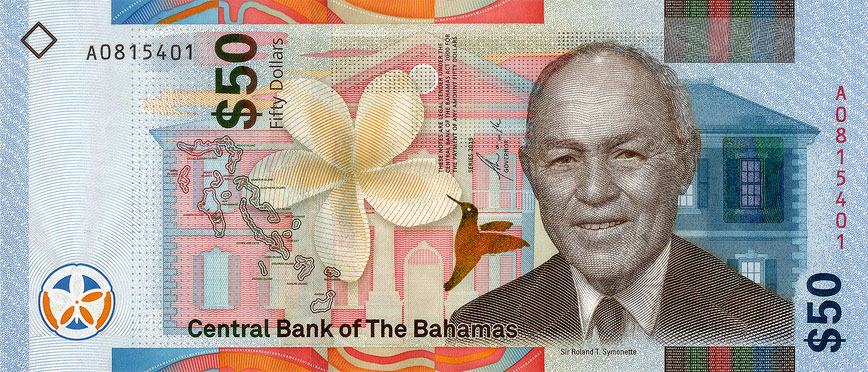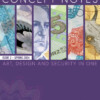Special awards have been made to a number of newly introduced banknotes and ID documents that have demonstrated outstanding technical sophistication and excellence in design and security.
The prestigious Regional Banknote and ID Document of the Year Awards form part of the industry’s High Security Printing (HSP) Latin America conference which, after an absence of nearly three years, returned with a swing to Mexico City this week.
Regional Banknotes of the Year
There are three categories for the Banknote awards – Best New Series, Best New Banknote and Best New Commemorative Banknote – and joint winners in two of those categories, with new banknotes from Mexico, the Eastern Caribbean, the Bahamas, Guatemala and Honduras all receiving recognition.
Best New Banknote Series
Joint winners of the Best New Banknote Series were the Central Bank of the Bahamas and the Eastern Caribbean Central Bank.
In October 2021, the Central Bank of the Bahamas released its new $100 banknote, completing the roll-out of its CRISP (Counterfeit Resistant Integrated Security Product) Evolution series which it began back in 2016.
The new series is – as the name suggests – an evolution of the original CRISP series first introduced in 2005, and is remarkable both for incorporating a broad cross-section of substrates, printers (including Orell Füssli, Crane Currency, De La Rue, Giesecke+Devrient and Canadian Bank Note) and features, and for its introduction of multiple firsts for feature-substrate pairings.
In total, the family comprises eight notes – ranging from from $½ to $100 notes.
The $1 and $5 were printed on Louisenthal’s Hybrid composite substrate with a RolllingStar thread.
The paper $20 was produced by De La Rue and features its Active thread. This made its debut on the new $10, issued in 2016, albeit that this was subsequently replaced by a note from Crane Currency with a RAPID Detect 4mm micro-optic security thread.
The $50 was produced on Landqart’s Durasafe substrate, and includes a MOTION RAPID thread from Crane. Not only was this the first note in the world to integrate the micro-optics feature into the composite substrate, but the window itself (at 33mm) is the longest to appear in a circulating note.
The eighth and final banknote of the new series – the $100 – was printed by the Canadian Bank Note Company on Durasafe substrate. It features a MOTION Surface stripe from Crane, another first for the combination of the two technologies.
In March 2021, the Eastern Caribbean Central Bank (ECCB) issued its new $5 polymer banknote, completing the transition of the Eastern Caribbean dollar to De La Rue’s SAFEGUARD polymer that began in 2019. According to the ECCB, the reasons for the transition were threefold – the environment, cost, and security.
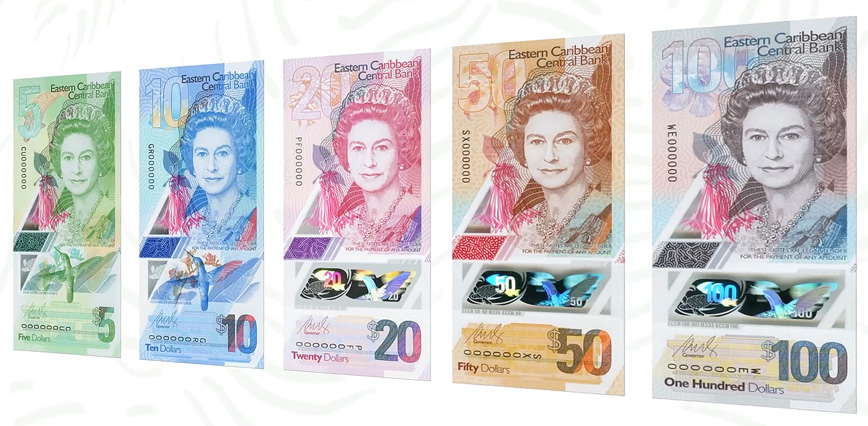
The banknotes are denominated in 5, 10, 20 50 and 100 dollars, and key to the ECCB’s decision to switch to polymer was the environment, according to its Governor, Timothy Antoine. The Caribbean is one of the lowest emitters of carbon dioxide in the world, he said, but one of the regions most impacted by global warming. The islands have a target of being net zero by 2022 and are well on the way to achieving this goal. The longer lifespan and lower environmental impact of polymer is part of this focus, as well as demonstrating moral authority and taking action on global warming.
The switch will also save on costs and allowed for the incorporation of advanced new security features.
The notes have been changed to a vertical orientation but remain the same size and dimensions – all uniform regardless of denomination. The colour scheme of the previous series has also been retained to aid public recognition and acceptance of the new notes, as have many of the design features, albeit that they have a much fresher and more modern appearance, helped by the portrait orientation.
They also incorporate a unique tactile emboss feature to aid recognition by the blind and visually impaired.
Best New Banknotes
The winner of the Best New Banknote was the Banco de México for not one but two notes – the new 50 and 100 pesos. The former – the sixth and final note in the new G series, was issued last November. It is produced on CCL Secure’s GUARDIAN polymer, along with the 100 pesos, issued the previous year, and the 20 pesos, also issued in 2021, which is a commemorative note celebrating the country’s bicentennial.
The design theme throughout the new series is events, buildings or people reflecting key stages in Mexican history on the front, and images reflecting the country’s eco-heritage and biodiversity on the reverse.
Both the 50 and the 100 are in a vertical orientation, front and back. Each incorporates a large complex transparent window that feature G-SWITCH and METALIX inks. The former changes colour from blue to gold when tilted. The latter is copper-coloured. They also incorporate an integrated magnetic thread and SPARK Live denoting the denomination numeral.
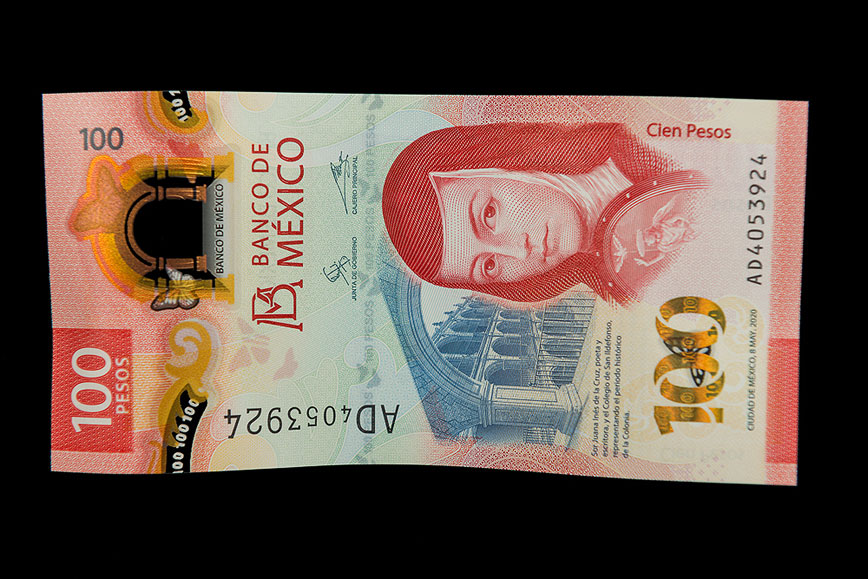
Best New Commemorative Banknotes
2021 was a landmark year for the region, with several countries celebrating their bicentennials, and issuing commemorative notes to mark the occasion. Because of the preponderance of such notes, and the high quality of these, two awards were made for Best New Commemorative Banknote, both from Central America.
One is the 200 lempira commemorative note issued last September by the Central Bank of Honduras (albeit that this is a new denomination, so it has become de facto a circulation note).
Honduras is known for its rich biodiversity and natural resources, which is reflected on the reverse of the note, showing two scarlet macaws (the national bird) flying over the UNESCO-listed Río Plátano Biosphere. The main image on the front of the note of children reading denotes the importance of education, which is seen one of the one of the fundamental pillars for the development of the nation
The 200 lempira note is the first in the world to feature a registered Galaxy thread with different and precisely positioned windows. When tilting the banknote, a change can be observed in the upper and lower windows from a bell, to 200, and vice versa. The middle window incorporates an image of a parchment and quill, and all three windows contain a dynamic circle that seems to move beneath the surface. Between the windows, the letters BCH can be viewed in transmission. The green-to-azure colour shift matches that of the SPARK feature.
The note was produced by Giesecke+Devrient and thread and paper by Louisenthal.
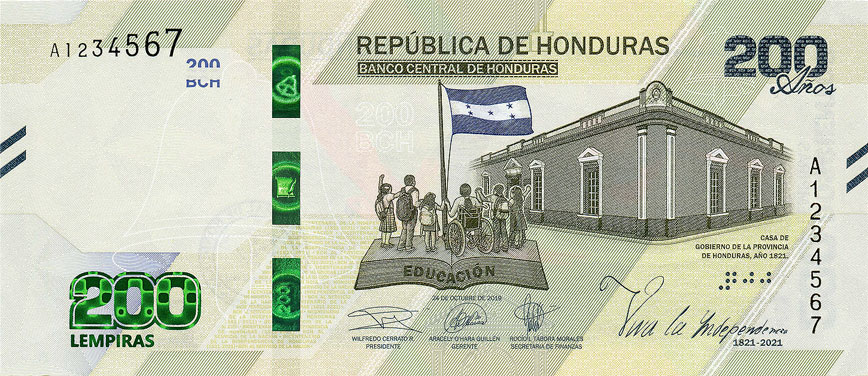
The other is the 20 quetzales, which is the first ever commemorative note to be issued by the Bank of Guatemala.
The note is vertically oriented on the front with themes relating to the country’s independence, and in a landscape format on the back, with a quetzal bird (after which the currency is named, and which appears on all the country’s notes).
The main overt security feature is a 5mm wide Galaxy thread with a double effect. When tilted horizontally, the thread displays an animation with a circle, embodying the number 20, moving up and down. But if the note is used in vertical format, ie. the same as the print orientation, it flips image from 20 to a quill. In both orientations it features colour shift from magenta-to-green.
This note was also produced by Giesecke+Devrient, and the thread and paper by Louisenthal.
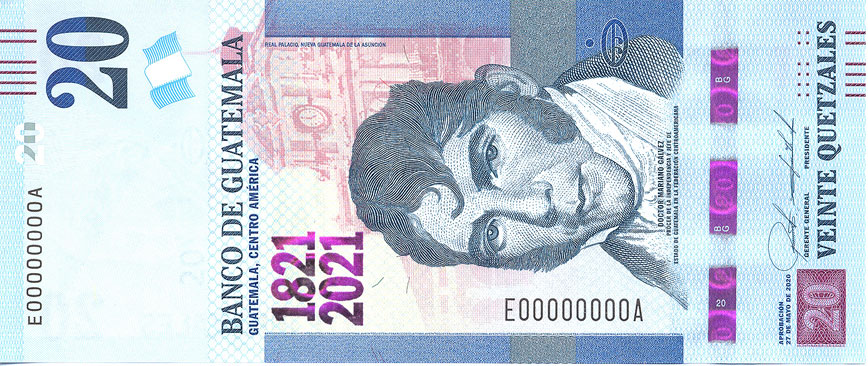
Regional ID Documents of the Year
The Regional ID Document awards, meanwhile, recognise outstanding achievement and technical sophistication of a personal identification or travel document programme. The awards are designed to promote the best in system infrastructure and implementation of a government passport, identity or other secure identification scheme.
Whilst the pace of new banknotes has continued unabated during the pandemic, the same cannot be said of ID documents, with many programmes put on pause. Hence there wasn’t such a broad selection of programmes to choose from as there were for bannotes, but there were nevertheless two worthy winners –
Best New National ID Card
The winner of the Best New National ID Card was THALES for its work on the National Record System Transformation in Honduras.
This programme was established to enhance citizens identity security with improved ID cards to prevent identity theft and also to establish a trust framework for interaction with various government services for Hondurans.
THALES was awarded the Honduras National ID card project, which was procured and financed by the United Nations Development Programme (UNPD) for the Honduras National Registration Office (RNP). The scope of the project was to provide 5.9 million national chipless polycarbonate ID’s along with the personalisation of 5.5 million IDs.
The laser engraved polycarbonate card contains three levels of security features including a DOVID hologram, changeable or multiple laser images, optically variable and UV fluorescent inks, microtext and barcode – providing a deterrence against the existing problem of fake IDs in Honduras.
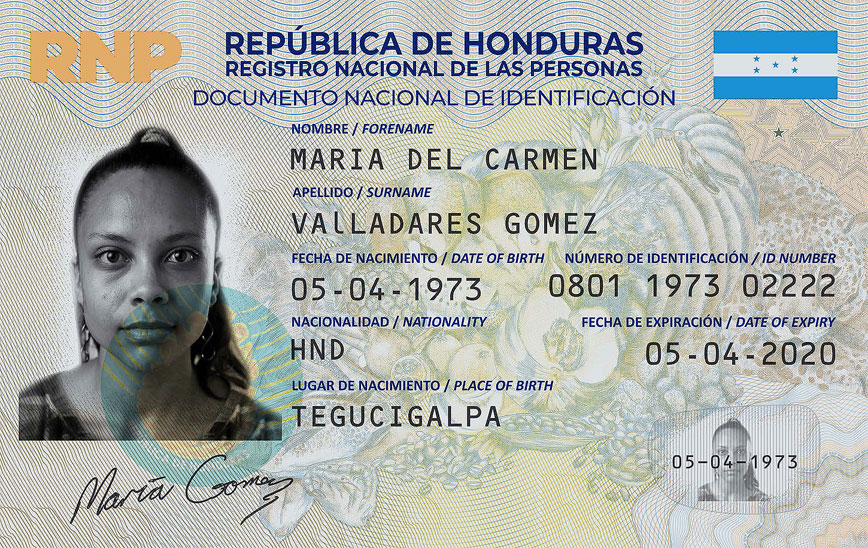
Best Civil ID Card
The winner of the Best Civil ID card was the INE (Instituto Nacional Electoral), the autonomous public organisation responsible for organising federal elections in Mexico.
One of the key responsibilities of the INE is to issue photo-voting cards to all citizens that have requested to be included in the electoral registry and is an essential document to exercise the right to vote in Mexico.
The INE card was a public open bidding tender process, won by a consortium formed by Veridos, Giesecke+Devrient, IECISA México (now INETUM) and HuBox. Veridos, G+D and IECISA México focused their efforts on the physical security elements of the document. HuBOX supplied the digital security element with their technology ‘Personal Code’ (the high density QR codes on the obverse of the card) and the verification app that functions in an offline mode and without database queries.
On the one hand, the INE credential includes top physical-security elements, and on the other an outstanding digital-security element. It was this combination of the best of the physical with the digital worlds of identity that earned the consortium the award for the photo-voting card.
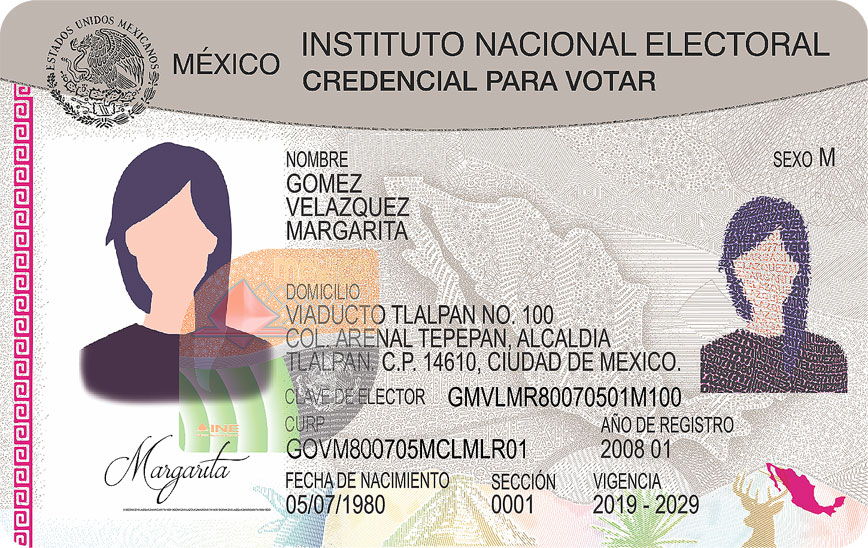
The awards were announced at a special ceremony during the HSP Latin America conference dinner on 15 March.
Also presented during the ceremony were the trophies for the awards that were made at the end of last year in the online version of the programme, held virtually in the absence for two years of the in-person events.
The winners for those awards in the banknote categories were the Central Bank of Costa Rica for the new 20,000 colones again for the whole series. The Banco de México won the Best New Commemorative Banknote award for the 20 peso celebrating the Mexican bicentennial.
For the ID categories, the winners were IDEMIA and the National Vital Statistics Registry of Colombia for the Colombia’s new eID card, and HID Global and the Argentine National Registry of People for Argentina’s Smart DNI.
